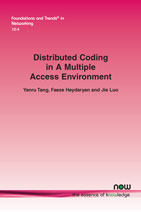Distributed Coding in A Multiple Access Environment
By Yanru Tang, Colorado State University, USA, yrtang@colostate.edu | Faeze Heydaryan, Colorado State University, USA, faeze66@colostate.edu | Jie Luo, Colorado State University, USA, rockey@colostate.edu
Abstract
With the fast expansion of communication networks and the increasing dynamic of wireless communication activities, a significant proportion of messages in wireless networks are being transmitted using distributed protocols that feature opportunistic channel access without full user coordination. This challenges the basic assumption of long message transmissions among coordinated users in classical channel coding theory. In this monograph, we introduce channel coding theorems for the distributed communication model where users choose their channel codes individually. We show that, although reliable message recovery is not always guaranteed in distributed communication systems, the notion of fundamental limit still exists, and can indeed be viewed as an extension to its classical correspondence. Due to historical priority of developing wireline networks, network architectures tend to achieve system modularity by compromising communication and energy efficiency. Such a choice is reasonable for wireline systems but can be disastrous for wireless radio networks. Therefore, to reduce efficiency loss, large scale communication networks often adopt wireless communication only at the last hop. Because of such a special structure, architectural inefficiency in wireless part of the network can be mitigated by enhancing the interface between the physical and the data link layers. The enhanced interface, to be proposed, provides each link layer user with multiple transmission options, and supports efficient distributed networking by enabling advanced communication adaptation at the data link layer. In this monograph, we focus on the introduction of distributed channel coding theory, which serves as the physical layer foundation for the enhanced physical-link layer interface. Nevertheless, early research results at the data link layer for the enhanced interface are also presented and discussed.
Distributed Coding in A Multiple Access Environment
With the computing power of mobile devices and wireless sensors exceeding previous generation large computers, the demand of wireless networking applications is increasing at a dramatic pace. Developments of advanced wireless networks, however, still suffer from the lack of a theoretical foundation that addresses both concerns of “efficiency” and “modularity”.
This monograph reviews a new research avenue that begins to address the research problem. Focusing on the physical and data link layers, it proposes an interface enhancement that overcomes an efficiency bottleneck in the wireless part of the network.
Distributed Coding in A Multiple Access Environment provides a state-of-the-art review of the topic and puts a framework for the efficiency of distributed networking systems when communication optimization cannot be done fully at the physical layer.
